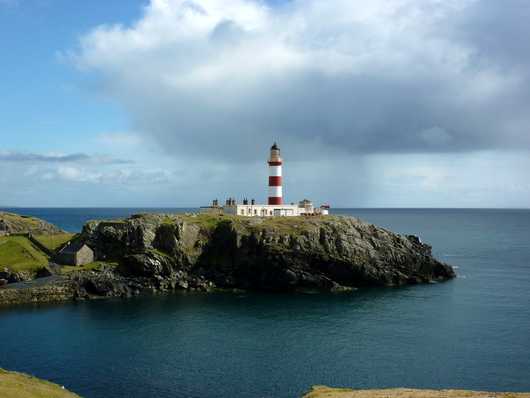Eilean Glas (1824)

Eilean Glas lighthouse, located at the Eastern end of Scalpay, is one of the most recognisable landmarks of the Outer Hebrides, and for many people travelling to the islands, it is one of the first structures they will see, as ferries heading to or from Tarbert pass it at close range.
This lighthouse, dating back to 1824 is easily distinguished by its colourful stripey daymark. It was built for the Northern Lighthouse Board to designs by Robert Stevenson, to replace the short tower his Stepfather Thomas Smith had designed and built in 1789. Remarkably, the 1789 structure, one of the four earliest lighthouses in Scotland, still survives in a derelict state at the base of the newer tower.
Stevenson's lighthouse is much taller, enabling it to be seen on a clear day all the way across the area of sea between the Outer Hebrides and Skye, known as The Little Minch.
Over the years many improvements continued to be made to the station; Circa 1845, Robert's Son, Alan Stevenson, was responsible for the construction of improved keepers' accommodation buildings, which were designed and built in his signature Egyptian Revival style, almost certainly inspired by the growing public fascination with the ancient world at that time. The single-storey flat roofed buildings were able to house a Principal keeper, and an Assistant keeper, and their families. The key features of the Egyptian influence can be seen in the cavetto cornicing, obelisk-like chimneys and sturdy pylon-like entrances and window surrounds.
In 1907 the station underwent several major improvements; the original lens was replaced by one manufactured by Chance Brothers of Birmingham, which produced three white flashes every 20 seconds, and a fog signal was installed. The increased workload that came with this required that a third keeper be stationed here, which resulted in a new house being built. The new fog signal was similar in appearance to most others in Scotland, utilizing a Diaphone that was amplified by a large steerable red trumpet, which could be rotated around a rack and pinion track to direct the sound.
Further developments at the lighthouse made in 1978 allowed the lighthouse to be both electrified and automated, at which time the lens and its weight-driven clockwork machinery were removed, and were replaced by a bank of sealed beam units on a much more lightweight pedestal driven by an electric motor. The fog signal was retired, and a very basic helipad was created at this time.
In 2019 the Sealed Beam units were replaced with a much smaller LED unit and a new backup lamp.
Sadly, determined vandals have attacked the lighthouse on a number of occasions, breaking windows and causing significant damage to the property, including to buildings now in private hands, and to some of the windows in the tower itself, which have since been boarded up and painted to match the red and white stripes. Ongoing efforts are being made to restore some of the buildings on the site, although this is a gradual project which is largely reliant on donations and sales made on site during the tourist season. Information about visiting the lighthouse can be found on the Friends of Eilean Glas Trust website. Be aware that the route to the site can be slippery and requires careful planning, as there is no road or established footpath. The 1907 lens and pedestal is on static display in the Science Museum in London.
